Global Digital X-Ray Market: By Technology, By Type, By Portability, By system, By Price Range, By Application, By End User, By Region & Segmental Insights Trends and Forecast, 2024 – 2034
- Industry: Healthcare
- Report ID: TNR-110-1145
- Number of Pages: 420
- Table/Charts : Yes
- June, 2024
- Base Year : 2024
- No. of Companies : 10+
- No. of Countries : 29
- Views : 10101
- Covid Impact Covered: Yes
- War Impact Covered: Yes
- Formats : PDF, Excel, PPT
Digital X-ray is an advanced imaging technology used in diagnostic radiology to capture detailed images of internal structures of the body with enhanced clarity and precision. Unlike traditional film-based X-ray systems, digital X-ray utilizes electronic detectors to convert X-ray photons into digital signals, which are then processed and displayed on a computer monitor. This digital imaging process offers several advantages, including faster image acquisition, higher image resolution, and greater flexibility in image manipulation and enhancement. Additionally, digital X-ray systems typically require lower radiation doses compared to film-based X-ray systems, reducing the risk of radiation exposure for patients and healthcare providers.
The digital format of the images allows for easy storage, retrieval, and sharing via electronic health records (EHR) and picture archiving and communication systems (PACS), facilitating seamless communication and collaboration among healthcare professionals. Digital X-ray technology continues to revolutionize diagnostic imaging by improving accuracy, efficiency, and patient care outcomes across various medical specialties and healthcare settings.
The demand for digital X-ray technology is primarily driven by its numerous advantages over traditional film-based radiography and its pivotal role in modern healthcare delivery. One of the key drivers is the increasing need for advanced diagnostic capabilities in healthcare facilities worldwide. Digital X-ray systems offer faster image acquisition, superior image quality, and lower radiation doses, leading to quicker diagnosis and treatment planning while minimizing patient exposure to radiation. Additionally, the transition from analog to digital systems is accelerated by the seamless integration of digital X-ray technology with picture archiving and communication systems (PACS) and electronic health records (EHR), enhancing workflow efficiency and facilitating seamless communication among healthcare professionals.
The rising prevalence of chronic diseases, aging population, and growing healthcare expenditure further fuel the demand for digital X-ray technology, as healthcare providers strive to meet the evolving needs of patients and deliver high-quality care in a cost-effective manner.
In terms of revenue, the global digital x-ray market was worth US$ 5.5 Bn in 2023, anticipated to witness CAGR of 4.2% during 2024 – 2034.

Global Digital X-ray Market Dynamics
Technological Advancements: Ongoing advancements in digital imaging technology, including improvements in image resolution, processing speed, and software capabilities, drive innovation and expand the functionalities of digital X-ray systems.
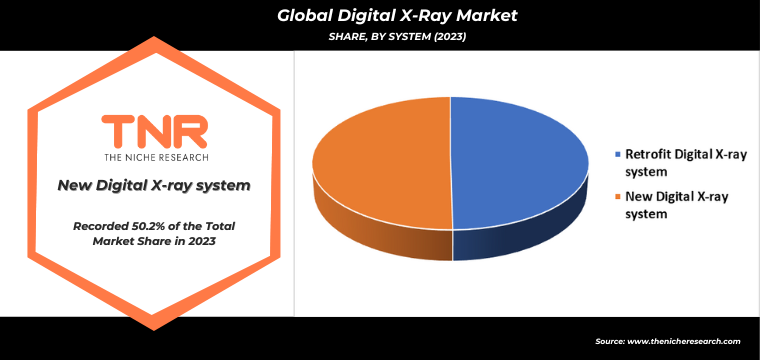
Rising Demand for Diagnostic Imaging: The increasing prevalence of chronic diseases, growing aging population, and rising healthcare expenditure worldwide contribute to a growing demand for diagnostic imaging services, including digital X-ray. The transition from analog to digital X-ray systems is accelerating, driven by the benefits of digital technology such as faster image acquisition, improved image quality, and enhanced workflow efficiency.
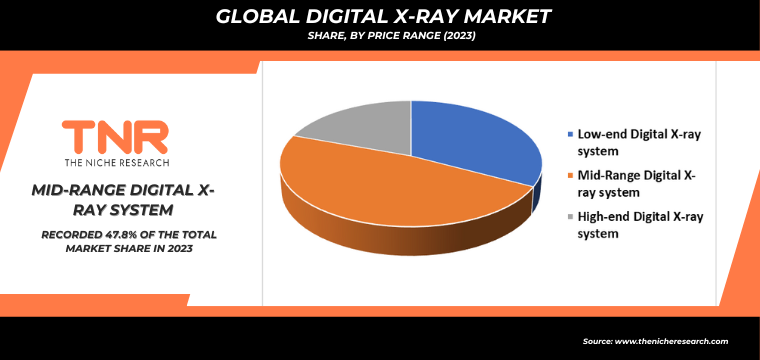
Integration with Healthcare IT Systems: Integration of digital X-ray systems with picture archiving and communication systems (PACS) and electronic health records (EHR) streamlines image management, enhances data accessibility, and improves workflow efficiency in healthcare facilities. Rapidly developing healthcare infrastructure, increasing disposable incomes, and rising awareness about advanced medical technologies in emerging markets contribute to the growth of the global digital X-ray market.
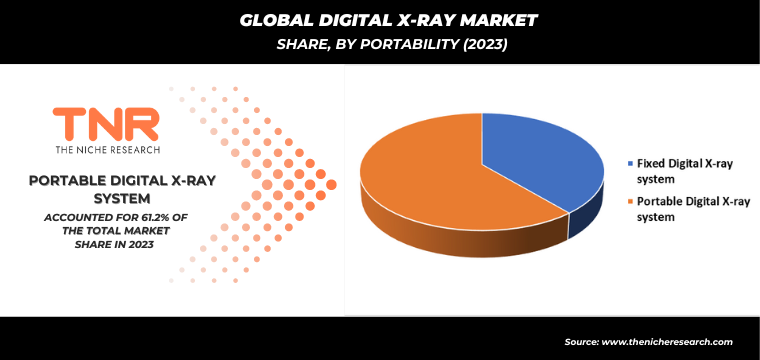
Regulatory Environment: Stringent regulatory requirements, quality standards, and compliance regulations influence product development, market entry, and adoption of digital X-ray systems globally. Efforts to reduce healthcare costs and improve operational efficiency drive the adoption of digital X-ray technology, as it offers long-term cost savings through reduced film and processing expenses, as well as improved productivity.
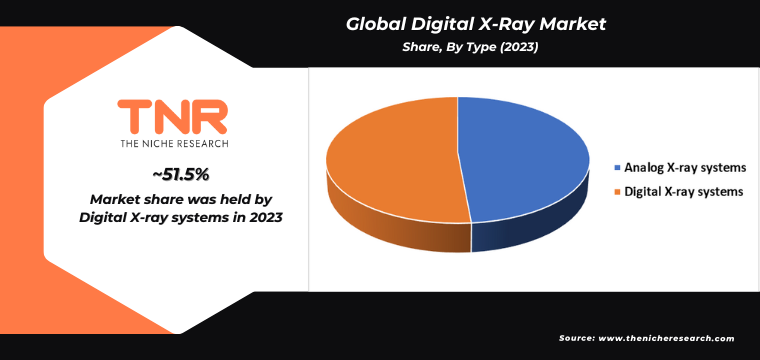
Imaging Segment has Garnered Major Market Share in the Global Digital X-ray Market During the Forecast Period (2024 – 2034).
The demand for digital X-ray technology in the imaging sector is strongly driven by its pivotal role in revolutionizing diagnostic capabilities and enhancing patient care. Digital X-ray systems offer numerous advantages over conventional film-based radiography, including faster image acquisition, superior image quality, and reduced radiation exposure for patients. These benefits have fueled a widespread adoption of digital X-ray technology across various imaging facilities, including hospitals, clinics, and diagnostic centers.
Moreover, the versatility of digital X-ray systems enables healthcare providers to perform a wide array of imaging procedures with exceptional precision and efficiency, ranging from routine screenings to complex interventional radiology procedures. The seamless integration of digital X-ray technology with picture archiving and communication systems (PACS) and electronic health records (EHR) further enhances workflow efficiency and facilitates seamless communication and collaboration among healthcare professionals. As the demand for advanced imaging solutions continues to rise, digital X-ray technology remains at the forefront of innovation, driving improvements in diagnostic accuracy, patient outcomes, and overall healthcare delivery.
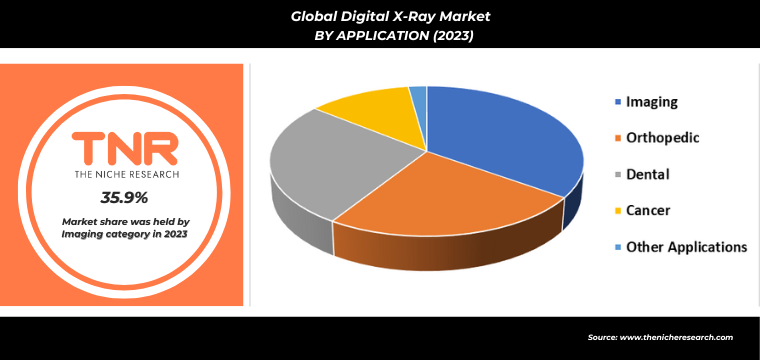
By End User Hospitals Segment had the Highest Share in the Global Digital X-ray Market in 2023.
Hospitals are a significant demand driver for digital X-ray technology, fueled by the need for advanced diagnostic capabilities, improved patient care, and enhanced workflow efficiency. Digital X-ray systems offer hospitals several advantages over traditional film-based radiography, including faster image acquisition, higher image quality, and lower radiation doses for patients. These benefits translate into quicker diagnosis and treatment planning, ultimately leading to better patient outcomes.
Additionally, the versatility of digital X-ray technology allows hospitals to perform a wide range of imaging studies, from routine chest X-rays to more complex procedures such as fluoroscopy and angiography. The seamless integration of digital X-ray systems with hospital information systems (HIS) and picture archiving and communication systems (PACS) streamlines image management and facilitates collaboration among healthcare professionals. As hospitals strive to deliver high-quality care while optimizing resource utilization, the adoption of digital X-ray technology continues to grow as a fundamental component of modern healthcare delivery.
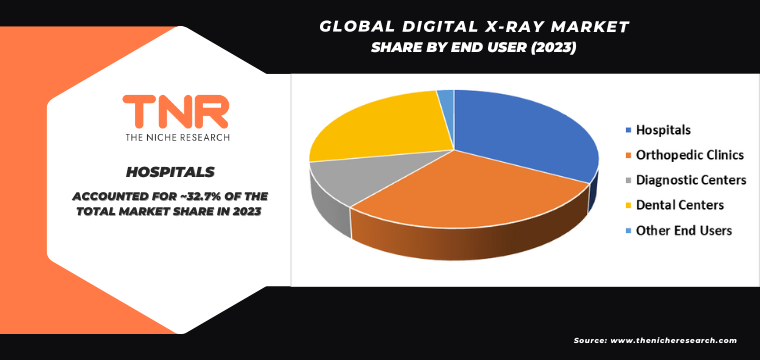
North America, by Region Dominated the Global Digital X-Ray Market in 2023.
The demand for digital X-ray technology in North America is being propelled by several key factors, with advancements in medical imaging technology chief among them. Digital X-ray systems offer numerous advantages over traditional film-based radiography, including faster image acquisition, enhanced image quality, and lower radiation exposure for patients. These benefits have led to widespread adoption across various healthcare settings, including hospitals, clinics, and diagnostic centers, as healthcare providers seek to improve diagnostic accuracy and patient care outcomes.
Additionally, the increasing prevalence of chronic diseases and the aging population in North America have created a growing need for diagnostic imaging services, further driving the demand for digital X-ray technology. Moreover, the integration of digital X-ray systems with picture archiving and communication systems (PACS) and electronic health records (EHR) facilitates seamless image management and improves workflow efficiency in healthcare facilities, contributing to the overall adoption of this technology. Overall, the pursuit of advanced imaging solutions to meet the evolving healthcare needs of the population serves as a significant demand driver for digital X-ray technology in North America.
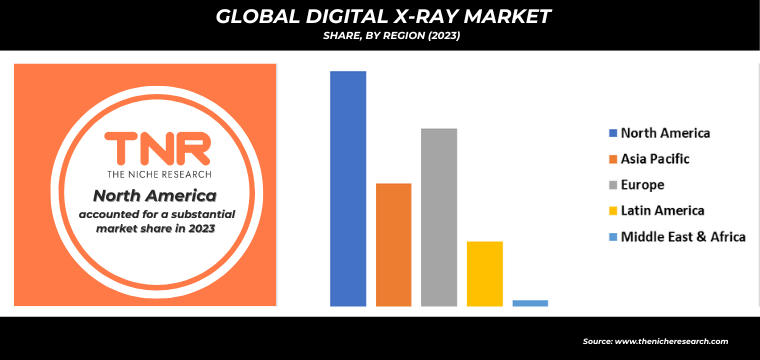
Competitive Landscape: Global Digital X-Ray Market:
- Boston Imaging
- Canon Medical Systems Corp.
- Carestream Health
- Fujifilm
- GE Healthcare
- Mindray Medical International
- Philips Healthcare
- Samsung Medison
- Shimadzu International
- Siemens Healthineers AG
- Other Industry Participants
Global Digital X-Ray Market Scope
| Report Specifications | Details |
| Market Revenue in 2023 | US$ 5.5 Bn |
| Market Size Forecast by 2034 | US$ 8.6 Bn |
| Growth Rate (CAGR) | 4.2% |
| Historic Data | 2016 – 2022 |
| Base Year for Estimation | 2023 |
| Forecast Period | 2024 – 2034 |
| Report Inclusions | Market Size & Estimates, Market Dynamics, Competitive Scenario, Trends, Growth Factors, Market Determinants, Key Investment Segmentation, Product/Service/Solutions Benchmarking |
| Segments Covered | By Technology, By Type, By Portability, By system, By Price Range, By Application, By End User, By Region |
| Regions Covered | North America, Europe, Asia Pacific, Middle East & Africa, Latin America |
| Countries Covered | U.S., Canada, Mexico, Rest of North America, France, The UK, Spain, Germany, Italy, Nordic Countries (Denmark, Finland, Iceland, Sweden, Norway), Benelux Union (Belgium, The Netherlands, Luxembourg), Rest of Europe, China, Japan, India, New Zealand, Australia, South Korea, Southeast Asia (Indonesia, Thailand, Malaysia, Singapore, Rest of Southeast Asia), Rest of Asia Pacific, Saudi Arabia, UAE, Egypt, Kuwait, South Africa, Rest of Middle East & Africa, Brazil, Argentina, Rest of Latin America |
| Key Players | Boston Imaging, Canon Medical Systems Corp., Carestream Health, Fujifilm, GE Healthcare, Mindray Medical International, Philips Healthcare, Samsung Medison, Shimadzu International, Siemens Healthineers AG |
| Customization Scope | Customization allows for the inclusion/modification of content pertaining to geographical regions, countries, and specific market segments. |
| Pricing & Procurement Options | Explore purchase options tailored to your specific research requirements |
| Contact Details | Consult With Our Expert
Japan (Toll-Free): +81 663-386-8111 South Korea (Toll-Free): +82-808- 703-126 Saudi Arabia (Toll-Free): +966 800-850-1643 United Kingdom: +44 753-710-5080 United States: +1 302-232-5106 E-mail: askanexpert@thenicheresearch.com
|
Global Digital X-Ray Market
By Technology
- Direct Radiography
- Computed Radiography
By Type
- Analog X-ray systems
- Digital X-ray systems
By Portability
- Fixed Digital X-ray system
- Floor-To-Ceiling -Mounted Systems
- Ceiling -Mounted Systems
- Portable Digital X-ray system
- Mobile X-Ray Systems
- Handheld X-Ray Systems
By System
- Retrofit Digital X-ray system
- New Digital X-ray system
By Price Range
- Low-end Digital X-ray system
- Mid-Range Digital X-ray system
- High-end Digital X-ray system
By Application
- Imaging
- Chest Imaging
- Pediatric Imaging
- Others
- Orthopedic
- Dental
- Cancer
- Other Applications
By End User
- Hospitals
- Orthopedic Clinics
- Diagnostic Centers
- Dental Centers
- Other End Users
By Region
- North America (U.S., Canada, Mexico, Rest of North America)
- Europe (France, The UK, Spain, Germany, Italy, Nordic Countries (Denmark, Finland, Iceland, Sweden, Norway), Benelux Union (Belgium, The Netherlands, Luxembourg), Rest of Europe)
- Asia Pacific (China, Japan, India, New Zealand, Australia, South Korea, Southeast Asia (Indonesia, Thailand, Malaysia, Singapore, Rest of Southeast Asia), Rest of Asia Pacific)
- Middle East & Africa (Saudi Arabia, UAE, Egypt, Kuwait, South Africa, Rest of Middle East & Africa)
- Latin America (Brazil, Argentina, Rest of Latin America)
Report Layout:
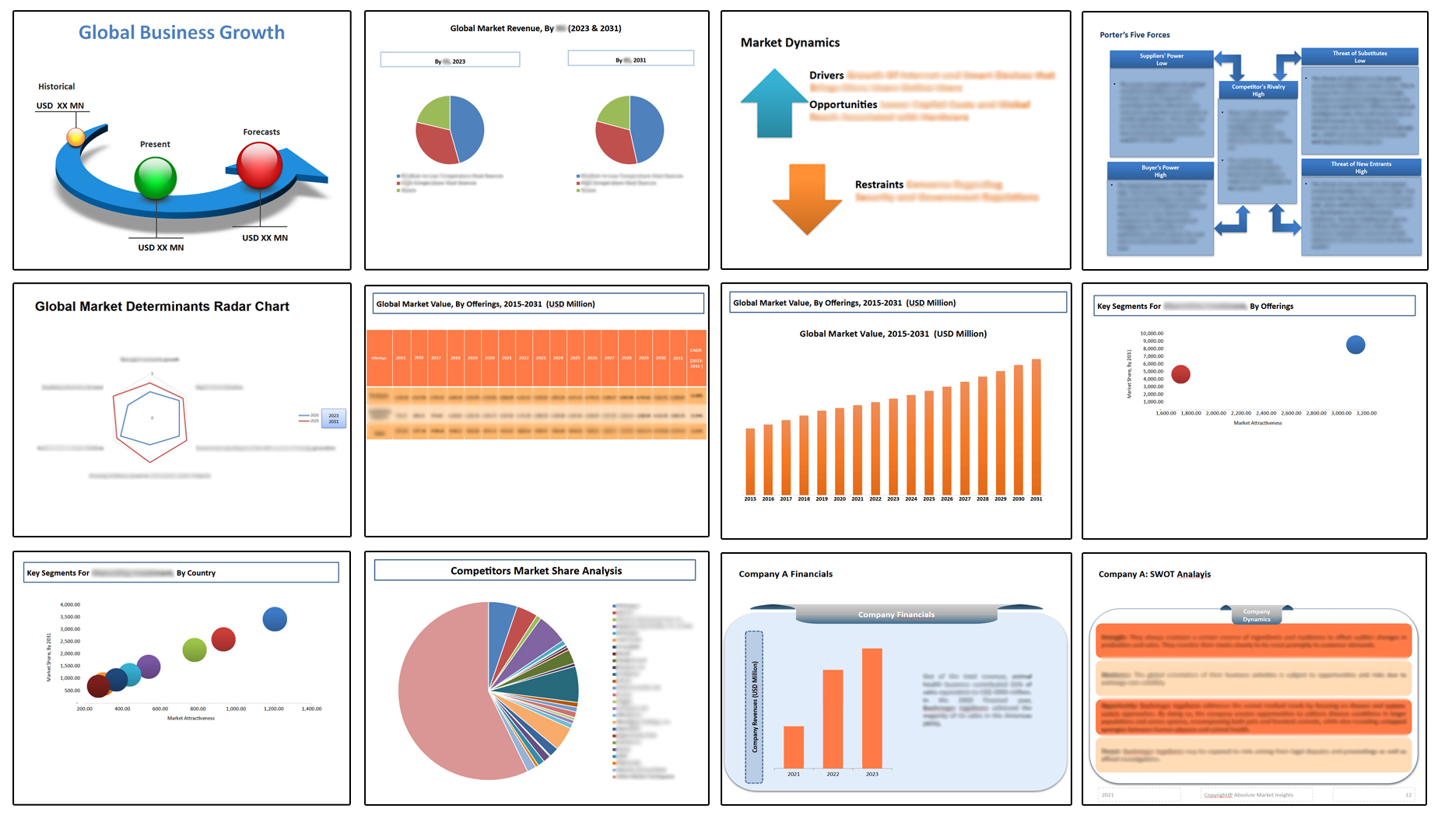
Table of Contents
Note: This ToC is tentative and can be changed according to the research study conducted during the course of report completion.
**Exclusive for Multi-User and Enterprise User.
Global Digital X-Ray Market
By Technology
- Direct Radiography
- Computed Radiography
By Type
- Analog X-ray systems
- Digital X-ray systems
By Portability
- Fixed Digital X-ray system
- Floor-To-Ceiling -Mounted Systems
- Ceiling -Mounted Systems
- Portable Digital X-ray system
- Mobile X-Ray Systems
- Handheld X-Ray Systems
By System
- Retrofit Digital X-ray system
- New Digital X-ray system
By Price Range
- Low-end Digital X-ray system
- Mid-Range Digital X-ray system
- High-end Digital X-ray system
By Application
- Imaging
- Chest Imaging
- Pediatric Imaging
- Others
- Orthopedic
- Dental
- Cancer
- Other Applications
By End User
- Hospitals
- Orthopedic Clinics
- Diagnostic Centers
- Dental Centers
- Other End Users
By Region
- North America (U.S., Canada, Mexico, Rest of North America)
- Europe (France, The UK, Spain, Germany, Italy, Nordic Countries (Denmark, Finland, Iceland, Sweden, Norway), Benelux Union (Belgium, The Netherlands, Luxembourg), Rest of Europe)
- Asia Pacific (China, Japan, India, New Zealand, Australia, South Korea, Southeast Asia (Indonesia, Thailand, Malaysia, Singapore, Rest of Southeast Asia), Rest of Asia Pacific)
- Middle East & Africa (Saudi Arabia, UAE, Egypt, Kuwait, South Africa, Rest of Middle East & Africa)
- Latin America (Brazil, Argentina, Rest of Latin America)
The Niche Research approach encompasses both primary and secondary research methods to provide comprehensive insights. While primary research is the cornerstone of our studies, we also incorporate secondary research sources such as company annual reports, premium industry databases, press releases, industry journals, and white papers.
Within our primary research, we actively engage with various industry stakeholders, conducting paid interviews and surveys. Our meticulous analysis extends to every market participant in major countries, allowing us to thoroughly examine their portfolios, calculate market shares, and segment revenues.
Our data collection primarily focuses on individual countries within our research scope, enabling us to estimate regional market sizes. Typically, we employ a bottom-up approach, meticulously tracking trends in different countries. We analyze growth drivers, constraints, technological innovations, and opportunities for each country, ultimately arriving at regional figures.Our process begins by examining the growth prospects of each country. Building upon these insights, we project growth and trends for the entire region. Finally, we utilize our proprietary model to refine estimations and forecasts.
Our data validation standards are integral to ensuring the reliability and accuracy of our research findings. Here’s a breakdown of our data validation processes and the stakeholders we engage with during our primary research:
- Supply Side Analysis: We initiate a supply side analysis by directly contacting market participants, through telephonic interviews and questionnaires containing both open-ended and close-ended questions. We gather information on their portfolios, segment revenues, developments, and growth strategies.
- Demand Side Analysis: To gain insights into adoption trends and consumer preferences, we reach out to target customers and users (non-vendors). This information forms a vital part of the qualitative analysis section of our reports, covering market dynamics, adoption trends, consumer behavior, spending patterns, and other related aspects.
- Consultant Insights: We tap into the expertise of our partner consultants from around the world to obtain their unique viewpoints and perspectives. Their insights contribute to a well-rounded understanding of the markets under investigation.
- In-House Validation: To ensure data accuracy and reliability, we conduct cross-validation of data points and information through our in-house team of consultants and utilize advanced data modeling tools for thorough verification.
The forecasts we provide are based on a comprehensive assessment of various factors, including:
- Market Trends and Past Performance (Last Five Years): We accurately analyze market trends and performance data from preceding five years to identify historical patterns and understand the market’s evolution.
- Historical Performance and Growth of Market Participants: We assess the historical performance and growth trajectories of key market participants. This analysis provides insights into the competitive landscape and individual company strategies.
- Market Determinants Impact Analysis (Next Eight Years): We conduct a rigorous analysis of the factors that are projected to influence the market over the next eight years. This includes assessing both internal and external determinants that can shape market dynamics.
- Drivers and Challenges for the Forecast Period:Identify the factors expected to drive market growth during the forecast period, as well as the challenges that the industry may face. This analysis aids in deriving an accurate growth rate projection.
- New Acquisitions, Collaborations, or Partnerships: We keep a close watch on any new acquisitions, collaborations, or partnerships within the industry. These developments can have a significant impact on market dynamics and competitiveness.
- Macro and Micro Factors Analysis:A thorough examination of both macro-level factors (e.g., economic trends, regulatory changes) and micro-level factors (e.g., technological advancements, consumer preferences) that may influence the market during the forecast period.
- End-User Sentiment Analysis: To understand the market from the end-user perspective, we conduct sentiment analysis. This involves assessing the sentiment, preferences, and feedback of the end-users, which can provide valuable insights into market trends.
- Perspective of Primary Participants: Insights gathered directly from primary research participants play a crucial role in shaping our forecasts. Their perspectives and experiences provide valuable qualitative data.
- Year-on-Year Growth Trend: We utilize a year-on-year growth trend based on historical market growth and expected future trends. This helps in formulating our growth projections, aligning them with the market’s historical performance.
Research process adopted by TNR involves multiple stages, including data collection, validation, quality checks, and presentation. It’s crucial that the data and information we provide add value to your existing market understanding and expertise. We have also established partnerships with business consulting, research, and survey organizations across regions and globally to collaborate on regional analysis and data validation, ensuring the highest level of accuracy and reliability in our reports.









